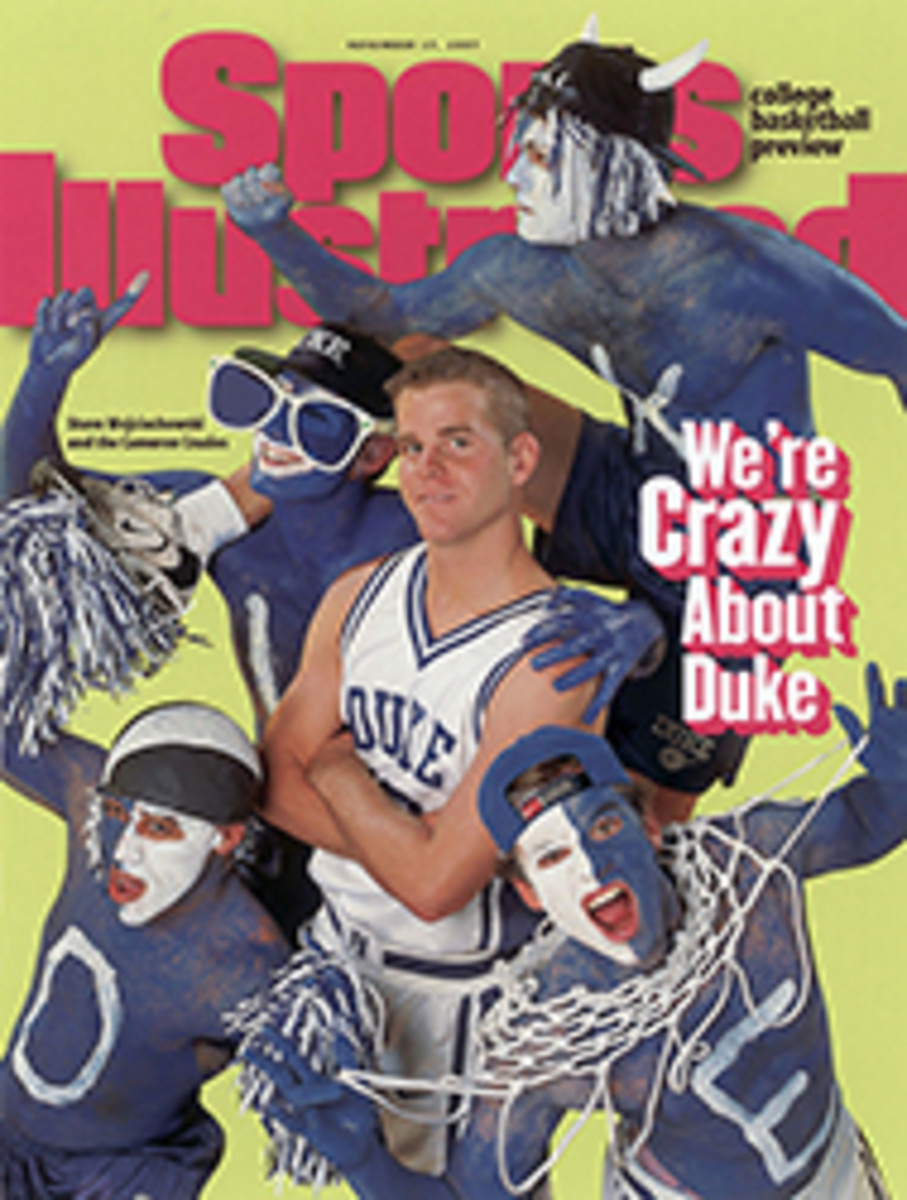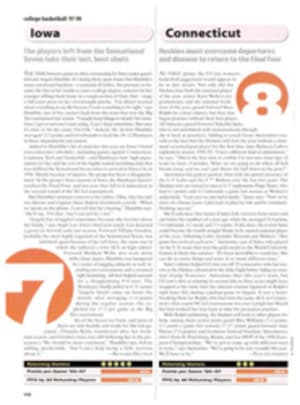
REVENGE OF THE NERDS MAGIC IS PLAYED WITH CARDS. IT'S WILDLY POPULAR. IT'S TOUGH TO EXPLAIN
There is a big bull's head hanging above the stairs in Seattle's
Wizards of the Coast Game Center. It is round and brown and
plastic and terribly ugly, and people here have taken to calling
it Head. In a face-to-face encounter with the beast, Richard
Garfield, a man who looks remarkably like Kermit the Frog,
grimaces, as would the amphibian. This was not my idea, his face
says.
Then--boom!--his idea. Down the steps and to the right, chaos
reigns. Two fat kids rush by, drinking Mountain Dew and talking
Star Trek. Another group of five kids huddles in a corner,
laughing over a deck of cards. "Merfolk Raiders!" one of them
yells. "Merfolk freeeeaaaaakkiiiin' Raiders!" Whatever. At long,
cloth-covered tables throughout the large room, boys, teens, men
sit quietly for hours, drugged by Garfield's own brand of "card
cocaine" (as one player calls it). Garfield turns, speaks. "This
is amazing," says the man responsible for Magic: The Gathering,
a wildly popular fantasy card game. "Who would've ever thought?"
Really, who would've? In all there are 500 participants from 35
countries here for the Magic: The Gathering world championships,
an event in August that has attracted a collection as eclectic
as the threads in the closet of the artist formerly known as
Prince. The setting is half high school math club, half the bar
scene from Star Wars. The scene at the tournament is like no
other, where man coexists peacefully with man and where dweebs,
skinheads, freaks, Guidos, preps, hippies and vamps are all well
represented. (Women, in spite of their participation generally
in the game, are notably absent.)
"You know what's neat about Magic?" asks Garfield. "That at its
core it's just a game. That's all I really wanted--a great game
that people who love games can enjoy. The goals were that simple."
All right, then, step back and check this out. Magic is not just
a game. It's a card game--the card game. It has been more
popular, according to trade association figures, over the past
four years than Monopoly, Trivial Pursuit and Hungry Hungry
Hippos (author's note: the most underrated game of all time).
Magic is a mix of poker and chess and Dungeons and Dragons, and
it is, says 17-year-old Justin Gary, the U.S. junior champion,
"the best game ever invented." Ever? "Of all time." According to
Wizards of the Coast, the Seattle-based company that publishes
Magic, two billion cards (offered in packs of 60 for
approximately $9 a set) have been sold to an estimated five
million consumers since Magic was introduced in 1993.
Five million.
That is why, over four days at these championships, Garfield is
the happiest man this side of Emmanuel Lewis at Webster
Appreciation Day. After all, Magic: The Gathering really was an
idea that--much like the Flux Capacitor--just hit him over the
head. "Seriously, it was the only true eureka! experience I've
ever had," says Garfield, 33, an absentminded type who wears
mismatched socks with his brown sandals and shorts. "I'd worked
on Magic card games as far back as 1982, but in the summer of
'91 the vision came. A game that could be as large as we wanted
it to be. The fantasy theme didn't come until later, but the
concept--I had it."
Up until that time, he was a board-game-business
nothing--someone with plenty of ideas but zip to show for them.
As an undergraduate at Penn in the mid-'80s, Garfield had dreams
of inventing games that people would play and play, and play and
play. It was simple but not easy. Later, as a graduate student
in combinational mathematics at Penn, he had his first
breakthrough with RoboRally, an oblique, overpriced robotic
concept hesitantly picked up by Wizards, a seven-year-old game
company. Then, while teaching math at Whitman College in Walla
Walla, Wash., Garfield showed Peter Adkison, the Wizards CEO,
this weird little card game--something he tentatively called
Magic.
"When Richard presented it, I fell in love instantly," says
Adkison, 36, like Garfield a certified eccentric. "I always
remember the moment he first described it to me--this whole
thing about a game that was played on cards, and the rules are
simple, and you can add cards and collect cards and trade. The
more he described it, the more I loved it. This was the game.
Not a game, the game."
The premise is relatively simple: A bunch of art-enhanced
fantasy cards and the rear corner of your local comic-book store
(where, Garfield knew, the game would spread through word of
mouth). Two players fill the roles of wizards, each with a deck
of colorful cards and 20 life points. The participants take
turns. The object is to slay your rival in a duel, utilizing
powers conferred by the cards to reduce the opposition's manta
(life energy) from the 20 to zero. The cards have names (such as
Merfolk Raiders and Skeletal Crocodile) and pictures of beasts
(the first picture was of Garfield's face smooshed onto the
screen of a photocopier) and make-believe lands, all of which
denote certain, measurable powers. Throw down a card and
different things may happen: You reduce your opponent's strength
by four. You put up a defense shield. Attack, attack, attack.
("It sounds worse than it is," says Gary.) With a virtually
unlimited number of cards, the game offers the possibility of
never repeating itself.
And now, primarily via the Internet and, as Garfield predicted,
word of mouth, Magic has gone from being the official game of
overweight, band-playing, debate-teaming geeks (code of conduct
rule number 6 at the Game Center: "Please practice daily hygiene
and tidy up after yourself") to being a professional sporting
event. The four-day August gala is part of a $1 million,
six-city world tour. ESPN2, home of aqua aerobics and
cheerleading spectaculars, is on hand. Avid fans are everywhere.
The biggest of the big-name players--Mark Justice and Mike Long,
Eric Tam and Gary--sign autographs and talk of the recently
completed Magic: The Gathering summer camp. There is a players'
union. There are participants from Seattle and New York City,
from South Africa and the Czech Republic. To get inside during
the tournament and watch a six-year-old card game, one must wait
in line for 20 minutes. Upstairs, dealers peddle Magic goods for
hundreds, sometimes thousands, of dollars in a building that was
erected specifically for Magic players.
The Game Center, right up the street from the University of
Washington's main campus, is a major draw for college students.
There is no charge for admission or for using a table. There are
lots of concessions, and the center stays open late--"sometimes
as late as people want to play," says Adkison. "It's a place
where people can come and feel comfortable about playing Magic."
The game is still powered by the average comic-book-store player
who buys pack after pack of cards and builds Magic sets as one
would a baseball-card collection. That, Adkison knows, is where
the money comes from. "So we try to give them what they want,"
he says.
Now, after years of struggling toward the mainstream, what Magic
players seem to want is a new image. "We're not saying there
aren't players who fit the stereotypes," says Jeff Donais, the
26-year-old Canadian star who supplied color commentary for
ESPN2's broadcast. "Of course, we have fat kids who smell. But
look at the other guys--the big players." They are polished and
poised guys like Justice, a 26-year-old Salt Lake City native
who sold a successful chain of comic-book stores to move to
Seattle and play Magic full time. They are Long, 22, a onetime
varsity wrestler at James Madison University. They are Sean (the
Hammer) Reginier, 28, a trash-talking, bandanna-wearing Lyle
Alzado look-alike who spent his early years as a professional
arm wrestler; Olle Rade, 17 and Swedish, with Axl Rose hair and
a nice roll of dough (he was the 1996 earnings leader with
$38,350); Tommi Hovi, a soft-spoken resident of Finland, with an
ice-cold glare; Michael Loconto, 28, a social worker from
Grafton, Mass.; and Donais, Canada's smooth-talking, stone-faced
champ. They range in age from South Korea's 10-year-old Kyung
Nyon Kim to some fans in their early 50's, and they are 100%
serious.
But is Magic--as advertised--a sport? "It's a heck of a lot more
of a sport than chess," says Long, rubbing his four-day-old
scruff for effect. "Look at the physical interaction. The cards
aren't just pieces of paper. You have to bring them to life.
"People laugh at us because we play a fantasy-based game. I'd
like to know what's wrong with fantasy. People go to movies all
the time and pay. I hauled down $26,000 at the tournament in
Paris," he says. "Call it what you want. It's working."
COLOR PHOTO: CORKY TREWIN In the Seattle final, Jakub Slemr (left) prevailed over Janosch Kuhn and earned a $34,000 prize.
COLOR PHOTO: CORKY TREWIN The game starts with a single pack of 60 fantasy cards, but then the possibilities explode exponentially. [Magic game box and playing cards]

